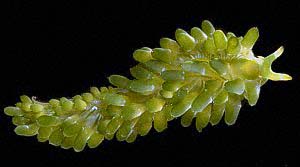
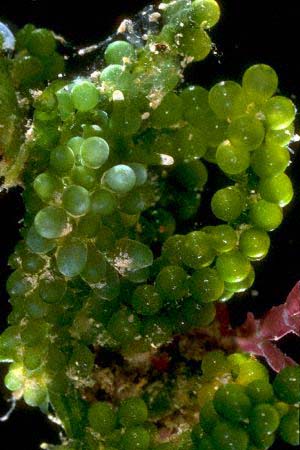
Stiliger smaragdinus
Baba, 1949
Order: SACOGLOSSA
Family: Limapontiidae
DISTRIBUTION
Described from Japan and reported from much of Australia, including Western Australia, South Australia, Victoria, New South Wales.
PHOTO
UPPER: Solitary Is, Coffs Harbour Region, New South Wales, Australia. March 1988. 39mm long. LOWER: Well-camouflaged animal [left of photo - note white-tipped rhinophores], 46mm long, on its food algae Caulerpa racemosa. Sthn Yorke Peninsula, South Australia, February 1985. AM C145205. PHOTOS: Bill Rudman.
RELATED TOPIC
Defensive coloration in sea slugs
Stiliger smaragdinus, like many algal feeding sacoglossans is almost invisible on its food as the algal colour pigments are retained in the digestive system and help to colour the animal. In this species the dorsal cerata have become an exact match, in size and shape, with the bubble-like bladders of the Caulerpa. Grows to 50mm in Australia.
Reference:
•Baba, K. (1949) Opisthobranchia of Sagami Bay. Iwanami Shoten, Tokyo. 211pp + pls.
Rudman, W.B., 1998 (October 14) Stiliger smaragdinus Baba, 1949. [In] Sea Slug Forum. Australian Museum, Sydney. Available from http://www.seaslugforum.net/find/stilsmar
Related messages
Stiliger smaragdinus? from New Caledonia
September 13, 2007
From: Jean-François Hervé
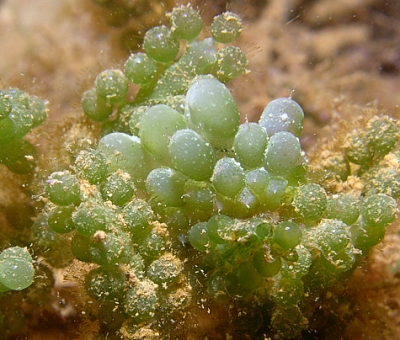
Concerning message #17400:
Dr Bill,
Few days after this Stiliger, I found in the same place as another limapontiid. Initially, I believed that it was a Stiliger smaragdinus but the head and rhinophores are different. Could you give me your opinion.
thank you for this fabulous daily work which you make on the forum.
Locality: Noumea, Ouémo beach, 12 m, New Caledonia, Pacific ocean, January 9th 2007, Algae, Caulerpe (Caulerpa sedoides ). Length: 25 mm. Photographer: Jean-François Hervé.
Jean-François Hervé
jfherve@free.fr
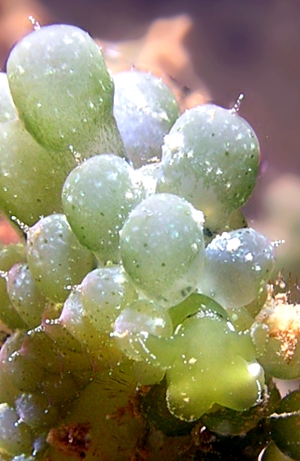

Dear Jean-François,
At first I thought your animal was the one I have tentatively called Ercolania sp 4, because of the shape of the cerata with the tapering papilla at the tip. But the rhinophores are quite different. In your animal each rhinophore is an enrolled tube or even ear-shaped. In Ercolania sp. 4 the rhinophores are thin tentacular structures with a branched duct of the digestive gland.
When I look at your earlier photo of Stiliger smaragdinus [#17400 ] the cerata also have this tentacle-like nipple at the tip of each ceras, but they differ from this animal in having the typical white band at the tip of the rhinophores.
I really can't say what it is. As I have said above, the ceratal tip is a puzzle, as are the short rhinophores. Perhaps Kathe Jensen can give us her opinion.
Best wishes,
Bill Rudman
First record of Stiliger smaragdinus from New Caledonia
August 10, 2006
From: Jean-François Hervé
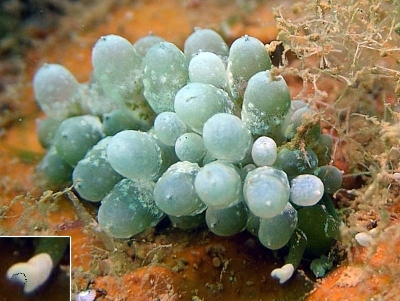
Dear Dr. Rudman,
Attached is a pictures of a nudibranch I observed one time in New Caledonian's lagoon at approximately 6 meters depth.
Locality: Noumea, 6 m, New Caledonia, Pacific Ocean, July 2006. Length: 1.5 cm. Photographer: Jean-François Hervé.
Could you help me? Thank you.
Jean-François Hervé
jfherve@free.fr
Hervé, J.F., 2006 (Aug 10) First record of Stiliger smaragdinus from New Caledonia. [Message in] Sea Slug Forum. Australian Museum, Sydney. Available from http://www.seaslugforum.net/find/17400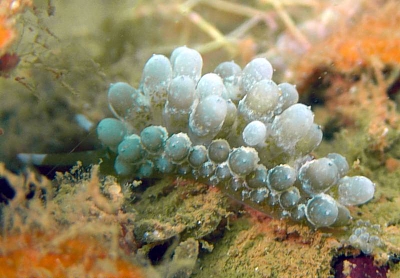
Dear Jean-François,
Congratulations on this nice find. Although it looks like an aeolid nudibranch, it is in fact a sacoglossan sea slug. One clue to it being a sacoglossan is the single pair of head tentacles, which are enrolled, as I show in the inset I have added in the upper photo.
This species, Stiliger smaragdinus, has an amazing resemblance to the green alga Caulerpa racemosa on which it lives and feeds. It feeds by sucking the cell contents out of the large bubble-like cells of the Caulerpa. First described from Japan. it has since been found in Australia and northern New Zealand.
It is almost certainly widespread in the tropical western Pacific, and I suspect the lack of previous records of it in New Caledonia, or anywhere else in the tropical Pacific, is because of its remarkably good camouflage.
Best wishes,
Bill Rudman
Stiliger smaragdinus from eastern Australia
February 3, 2006
From: Bruce Potter
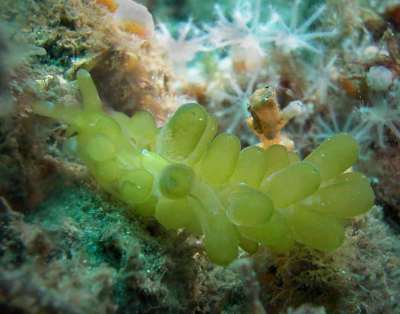
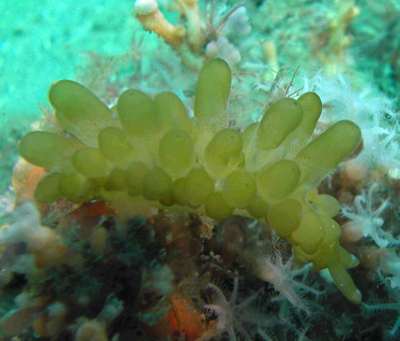
Dear Bill,
I found this sacoglossan at Fly Point in Nelson Bay this morning. Would I be correct in identifying it as Stiliger smaragdinus?
Locality: Fly Point, Nelson Bay, NSW, Australia. Depth: 8 metres. Length: 30 mm, 29 January 2006. rocky, sponges, algaes, weeds. Photographer: Bruce Potter
Regards
Bruce Potter.
bandppotter@bigpond.com
Potter, B., 2006 (Feb 3) Stiliger smaragdinus from eastern Australia. [Message in] Sea Slug Forum. Australian Museum, Sydney. Available from http://www.seaslugforum.net/find/15702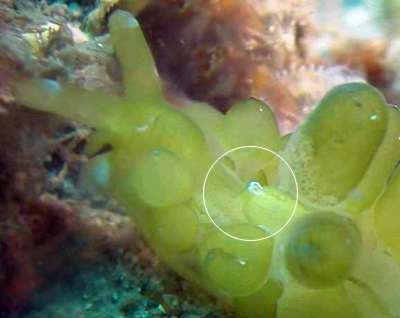
Dear Bruce,
Yes this is Stiliger smaragdinus. I have included a close-up alongside as it shows the white-tipped anal papillae on the front of the pericardial swelling.
Best wishes,
Bill Rudman
First record of Stiliger smaragdinus from NZ
February 17, 2005
From: Alan Morrison
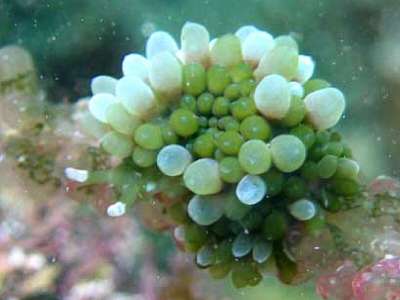
Dear Bill,
Thank you for your interest in my postings on Wade Doak's website. The pictures were both taken in a small bay at Taiharuru a few kilometers north of the entrance to Whangarei Harbour in January this year. The grapeweed slugs were in about 4-5 metres of water and between 5-10mm long. My buddy had seen one there the previous summer and we found four more this year
See post on Wade Doak's website at:[http://www.wadedoak.com/_disc1/0000045b.htm ].
Cheers,
Alan Morrison
aquaman@maxnet.co.nz
Morrison, A., 2005 (Feb 17) First record of Stiliger smaragdinus from NZ. [Message in] Sea Slug Forum. Australian Museum, Sydney. Available from http://www.seaslugforum.net/find/13124
Dear Alan,
This slug is the sacoglossan Stiliger smaragdinus. It is also known from southern Australia and Japan. How common it is is a bit difficult to determine because it is so well camouflaged, and so usually missed by all but the most indefatigable searchers. Often the only sign of its presence are the white-tipped rhinophores,
Willan & Morton (1984) mention that 'A new Hermaea species has been found in association with Caulerpa sedoides which it matches in both shape and colour' from Leigh, north of Auckland. Their 'Hermaea' is most probably this species. As far as I can find, your photo is the first definite record of this species in New Zealand.
-
Willan, R.C.; Morton, J.E. 1984: Marine Molluscs Part 2: Opisthobranchia. University of Auckland, Leigh Marine Laboratory, Leigh, New Zealand. 1-106.
Best wishes,
Bill Rudman
Re: Stiliger smaragdinus in Japan
August 6, 2001
From: Kathe R. Jensen
Dear Bill and Cynthia,
Sorry that I never got around to doing that generic description. This was something I discussed with Bob Burn, when I visited him more than 10 years ago. At that time I had only seen very small specimens, and didn't really believe him, when he claimed it differed so much from other species of Stiliger. However, when I found the mature specimens in Darwin Harbour, I had to agree about at least one character he had mentioned: they had like a "flange" on the stems of the larger cerata (like gills in some Doto species). So I contacted Bob Burn again, and we were supposed to write this "new genus" together - I think he has a "manuscript name" for it ready. However, then my contract at the Zoological Museum in Copenhagen expired, and I had to go to Finland. And since then I just haven't had time to look into this. After Cynthia sent me her note about the Japanese specimens, I looked in some of my old notes. It seems that most of the characters separating it from Stiliger (as well as from Hermaea and Caliphylla) are actually plesiomorphic, which would not qualify for a new genus. So, as you can see, I am still in doubt about its generic status. However, I can say that it is not an Aplysiopsis. It does not have the characteristic sabot-shaped teeth, nor the distal bifurcation on the rhinophores. The shape of the albumen gland is most similar to the hermaeid type, and if we accept this branching pattern as an apomorphic character, then it would be a "primitive" hermaeid - and therefore not a Stiliger (which is in the Limapontiidae).
Now I think I have made everybody confused - but I am also confused myself. This certainly shows that even a species which is easily identified can be very difficult to place in its "natural position" in the hierarchy of classification (and that one should never publish sentences like "a description of a new genus is in progress").
Cheers,
Kathe
jensen@ait.ac.th
Jensen, K., 2001 (Aug 6) Re: Stiliger smaragdinus in Japan. [Message in] Sea Slug Forum. Australian Museum, Sydney. Available from http://www.seaslugforum.net/find/4908Dear Kathe,
Thanks for the progress report.
Best wishes,
Bill Rudman.
Stiliger smaragdinus in Japan
July 24, 2001
From: Cynthia Trowbridge
Dear Bill,
Hi! I am back in Japan now looking at sacoglossans. Last night I looked at your page on Stiliger smaragdinus to remind myself of its appearance and this morning found four of them!!! I am so thrilled at having the Slug Forum - thank you for all the hard work for this important resource.
Anyway, first, I wanted to mention that the specimens are much larger than I expected - 3 to 4 cm. Previously, I had been looking for animals about 3-4 mm since most sacoglossans I have seen are pretty small. Roughly how large are your Australian animals? mm or cm?
Second, a query about the name. In Baba & Hamatani (1970), they suggest (pp. 203-4) that Stiliger smaragdinus should be assigned to Hermaeina smaragdina for its denticulated teeth and diaulic genitalia. But, Hermaeina has been changed to Aplysiopsis, right? So, would this make this species Aplysiopsis smaragdina (or A. smaragdinus)? [Sorry, I do not know the gender of these genera.] Or, is this species still Stiliger smaragdinus? Any thoughts by you or other readers would be much appreciated! Thank you.
• Baba, K. & Hamatani, I. 1970. Occurrences Of Specimens Presumably Identifiable With Stiliger ornatus At Seto, Kii, Middle Japan, Opisthobranchia Sacoglossa. Publ. Seto Mar. Biol. Lab., 18(3): 1970. 199-206.
Cordially,
Cynthia
trowbric@ucs.orst.edu
Trowbridge, C., 2001 (Jul 24) Stiliger smaragdinus in Japan. [Message in] Sea Slug Forum. Australian Museum, Sydney. Available from http://www.seaslugforum.net/find/4888Dear Cynthia,
Glad you find the Forum useful and sorry about lack of measurements on the S. smaragdinus page. Although its a great advantage being able to work from home, sometimes I forget to add a detailthe next morning at the museum. I have added some measurements to the photos. It is indeed a relatively big sacoglossan growing to at least 50mm long here in Australia.
Concerning its genus, you are right it has been everywhere - in Stiliger, Aplysiopsis, Hermaeina and Ercolania. Kathe Jensen (1996,1997) - has it in "Stiliger" with inverted commas and says she is preparing a description of a new genus for it.
• Jensen, K.R. (1996) Phylogenetic systematics and classification of the Sacoglossa (Mollusca, Gastropoda, Opisthobranchia). Philosophical Transactions of the Royal Society of London, B 351: 91-122.
• Jensen, K.R. (1997) Sacoglossa (Mollusca, Opisthobranchia) from the Darwin Harbour Area, Northern Territory, Australia. In: Proceedings of the Six International Marine Biological Workshop. The marine flora and fauna of Darwin Harbour, Northern Territory, Australia. (Eds: Hanley,JR; Caswell,G; Megirian,D; Larson,HK) Museums and Art Galleries of the Northern Territory and the Australian Marine Sciences Association: Darwin, Australia, Darwin, 163-186.
